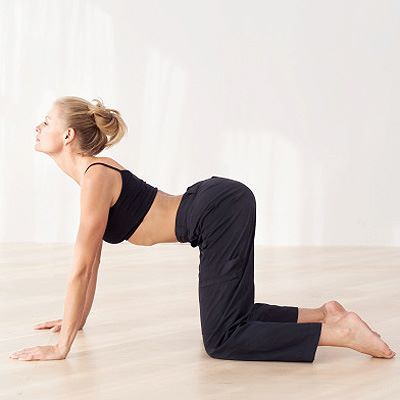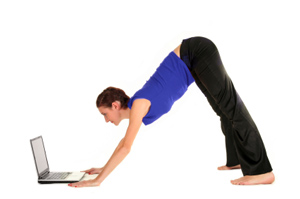9 Go To Yoga Poses for Back Pain
Like many people, I have suffered from nagging lower back pain for years. I've come to learn that there are many causes for chronic pain in the lower back and depending on the individual, there can be a variety of solutions. In my own journey I have found that a yoga practice (combined with other forms of exercise) has given me lots of relief from this ailment.
I will probably spend more time on this blog writing about my own ups and downs with back issues, but for now I'd like to enlighten you to some yoga moves to help those with similar problems. While there are hundreds of individual yoga poses, these are the ones I have found to be very effective in alleviating that dreaded lower back pain. These 9 Poses are great for relief, but if you want a comprehensive guidebook (complete with photo instructions), click here.
In the meantime, let's here are my go to poses:
Knees To Chest
Lie on your back and draw your knees towards your chest. Breathe in and out squeezing your legs gently towards you on your out-breaths.
Cat/Cow
Starting in an all-fours position, move into cat pose by slowly pressing your spine up, arching your back. Hold for a few seconds and then move to cow by scooping your spine in, pressing your shoulder blades back and lifting your head. Moving back and forth from cat to cow helps move your spine onto a neutral position, relaxing the muscles and easing tension.
Seated or Standing Forward Fold
From a seated position with your legs extended forward, reach for your shins, ankles, or feet, bending at the hips. Instead of rounding your back, continue to reach your sternum forward, lengthening the torso. If this hurts your back, bend your knees as needed.
Child's Pose
Kneel on the floor. Touch your big toes together and sit on your heels, then separate your knees about as wide as your hips. Exhale and lay your torso down between your thighs. Broaden your sacrum across the back of your pelvis and narrow your hip points toward the navel, so that they nestle down onto the inner thighs.
Lengthen your tailbone away from the back of the pelvis while you lift the base of your skull away from the back of your neck. Lay your hands on the floor alongside your torso, palms up, and release the fronts of your shoulders toward the floor. Feel how the weight of the front shoulders pulls the shoulder blades wide across your back.
Camel Pose
Kneel on the floor with your knees hip width and thighs perpendicular to the floor. Rotate your thighs inward slightly, narrow your hip points, and firm but don't harden your buttocks. Keep your outer hips as soft as possible. Press your shins and the tops of your feet firmly into floor.
Rest your hands on the back of your pelvis, bases of the palms on the tops of the buttocks, fingers pointing down. Use your hands to spread the back pelvis and lengthen it down through your tail bone. Then lightly firm the tail forward, toward the pubis
Lean back against the firmness of the tail bone and shoulder blades. For the time being keep your head up, chin near the sternum, and your hands on the pelvis.
Release the front ribs and lift the front of the pelvis up, toward the ribs. Then lift the lower back ribs away from the pelvis to keep the lower spine as long as possible. Press your palms firmly against your soles (or heels), with the bases of the palms on the heels and the fingers pointing toward the toes. Turn your arms outwardly so the elbow creases face forward, without squeezing the shoulder blades together. You can keep your neck in a relatively neutral position, neither flexed nor extended, or drop your head back.
Plow Pose
credit
From Shoulder Stand, bend at your hips to bring your toes or top of your feet to the floor. Your hands can remain against your back for support, or you can clasp them together, keeping your forearms on the floor. Hold this as long as is comfortable to get a powerful stretch in your shoulders and spine. If this is too much, you can place a chair behind and you rest your feet on the chair.
Knee Twist or Spinal Twist
Starting in a seated position, bring your left foot outside your right knee. Extend your right arm up, hook your right elbow outside your left knee and look over your left shoulder. Hold for three breaths before repeating on the opposite side.
Thread the Needle or Pigeon
For Thread the Needle:
Lying on your back, bend both knees with the feet flat on the ground. Bend the right knee like a figure four, with the outer left ankle to the right thigh. Lift the left foot into the air, bringing the left calf parallel to the ground. Thread your right hand between the opening of the legs and interlace your hands behind your left thigh. Hold 2-3 minutes and then repeat on the other side.
For Pigeon:
From all-fours, bring your right knee behind your right wrist with your lower leg at a diagonal toward your left hip. Square off your hips toward the ground. Bend forward. Widen the elbows and place one hand on top of the other as a pillow for your forehead. Hold 2-3 minutes and then switch to the left side for 2-3 minutes.
Upward Dog + Downward Dog
For Upward Dog:
Begin by lying face-down on the floor with your legs extended behind you, spread a few inches apart. The tops of your feet should rest on the mat. Place your hands on the floor alongside your body, next to your lower ribs. Point your fingers to the top of the mat and hug your elbows in close to your ribcage.
Inhale as you press through your hands firmly into the floor. Straighten your arms, lifting your torso and your legs a few inches off the floor. Press down firmly through the tops of your feet. Strongly engage your leg muscles to keep your thighs lifted off the floor. Keep your elbows pressed alongside your body. Drop your shoulders away from your ears and lift your chest toward the ceiling.
Draw your shoulders back and your heart forward, but do not crunch your neck. If your neck is flexible, tilt your head to gaze toward the sky. Otherwise, keep your head neutral and your gaze directly forward.
For Downward Dog:
Start in tabletop and raise your hips so your body is in an upside down V position. Relax your head and neck and draw your inner thighs toward the back of the room. Spreading your shoulder blades apart will stretch your upper back even more, and reaching your hips up and back will help to open your lower back. Breathe for five to seven breaths.









